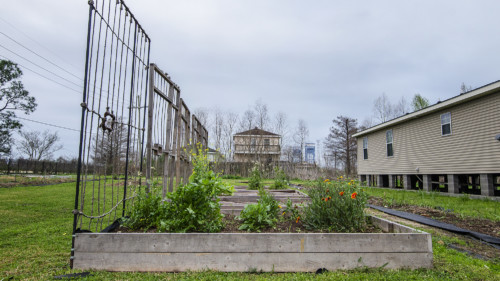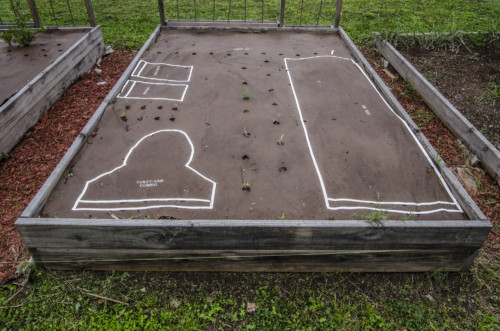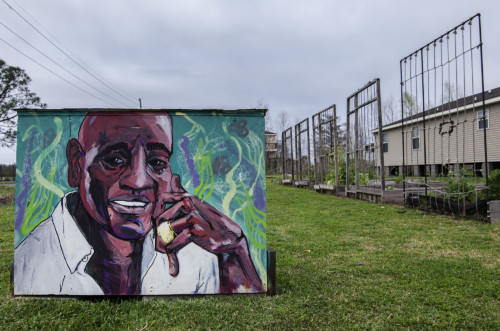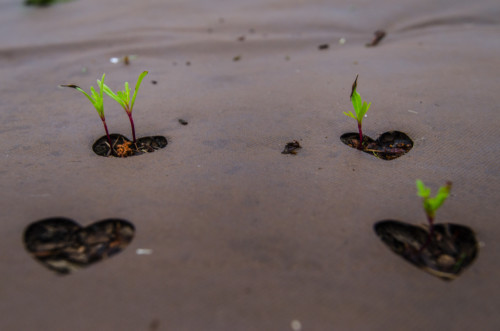
How Solitary Gardens Imagines A Landscape Without Prisons
“Solitary Gardens is dedicated to illustrating possibilities beyond incarceration. It hopes to contribute to a landscape that does not rely exclusively on prisons and inhumane conditions, like solitary confinement, to address social failings and so-called crimes in our communities,” artist jackie sumell tells GC.
Based in New Orleans, Solitary Gardens is part public art piece, part social sculpture, and part cultivated oasis, and is composed of garden beds that mirror the blueprint of six-by-nine foot American solitary cells. The gardens are “tended” by prisoners who select what they would like planted through written correspondences with volunteers; the volunteers in turn send photographs of the garden’s progress to the “Solitary Gardeners.” Standing at a curious intersection of time and place, choice and custody, growth and confinement, the project asks its viewers: “Can you imagine a landscape without prisons?”
A forceful activist and artist, sumell is no stranger to provocative, politically charged works. Prior to Solitary Gardens, sumell developed Herman’s House, an exhibition that later became a book and documentary film; sumell sees her current work on Solitary Gardens as a progression of the earlier piece.
“Solitary Gardens was inspired by the life and legacy of Herman Wallace who wrongfully spent forty-one years in solitary confinement in the state of Louisiana,” sumell explains. “Despite this grave injustice, his compassion and dedication to serving humanity was unwavering. As part of this commitment, Herman dreamed of vast gardens for his home, because they reminded us of life, beauty, and possibility; all of which are contraindicated by the prison system.”
Both Herman’s House and Solitary Gardens operate in conjunction with a question: the former around “What kind of house does a man who has lived in a six-foot-by-nine-foot cell for over 30 years dream of?”, which sumell asked Wallace in 2013; the latter around the aforementioned appeal to envision a landscape without prisons. Inherent in both is a provocation, a demand on the critical imagination to rethink systems as they are, and to rise above them.
With the hope of engendering action, sumell’s aim is for the Solitary Gardens to be a “physical platform for collaboration, education, and commiseration”; towards that end she is currently developing a ‘Handshake Curriculum’ to accompany the Solitary Gardens as they expand to new sites (like UC Berkeley and the American Visionary Art Museum) around the US.
“This curriculum will outline ways to begin conversations around prison abolition as a viable solution to mass incarceration,” sumell reveals. “It is our hope that this curriculum will empower folks to discuss the advantages of alternatives to incarceration in a short conversation. It will also suggest various resources for those who are interested in knowing more. We are also developing permaculture curriculum for the Solitary Gardeners, so that they can develop a gardening skill set for when they come home.”
In this way, sumell’s work not only draws attention to injustice and to inspire the public to action, but attempts, in some way, to heal the trauma from a profoundly broken system. Though the Solitary Gardens seem to draw comparison with community gardens and the spatial healing that happens there, sumell is careful to differentiate her work.
“It’s more of a reclamation of humanity and dignity than space,” sumell reflects of the superficial resemblance. “Solitary confinement is a mechanism of torture that is applied to human beings who have been ‘othered.’ Isolation has become the go-to method of punishment for folks who identify as queer or trans, political prisoners who challenge the system, or those who suffer from mental illness. Solitary confinement is employed to dehumanize and silence people, many of whom are in solitary confinement simply because prison officials did not know how to deal with them humanely. Solitary Gardens is a way to give those folks voice, presence, purpose, and restoration of their humanity and dignity. In many ways the solitary cells become portraits of human beings that have been kept in cage by our institutions.”
Beyond the immediate call to end solitary confinement, Solitary Gardens traces the thread of slavery throughout American history into its contemporary form: the prison industrial system. As sumell writes of the project on her site, “Slavery did not end, as is commonly believed, in 1865; it merely evolved.” In pointed reference to this legacy, the Solitary Gardens are quite built using sugar cane, cotton, tobacco, and indigo, which sumell informs us are “the largest chattel slave crops in the colonized United States.”
“They played an integral role in the capital gains of divisible American ‘success,’ which is often ignored by our historical and educational narratives,” sumell continues. “When we look at incarceration, we see many capital gains only made possible when able-bodied folks are forced to work for two to twenty cents per hour for the profit of an institution. As a direct reflection, many people view our state of hyper incarceration as a form of enslavement. Solitary Gardens will illustrate the evolution of slavery into mass incarceration by building the garden beds (which look like prison cells) out of the byproducts of those chattel crops.”
Like nature itself, Solitary Gardens grows from the ashes of its own history, drawing on the storied tradition of nature as restoration. Both by using “the chattel crops” and by encouraging the Solitary Gardeners to grow what they want, the plants become a means to literally and figuratively overcome.
As sumell explains, “Plants are grown only in the negative space of the cell where one has mobility. This serves to show what little space for movement exists within a solitary confinement cell, since most of the space is already taken up by a bed, chair, desk, and toilet/sink combo. From a small area of space comes the larger-than-life presence of plants which overcome the entire cell, transforming it from a place of confinement to a place of limitless transformation and growth. This reflects the potential for our society to dream far beyond what we imagine is possible.”
To learn more about Solitary Gardens, visit their website.





































